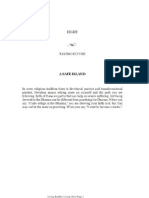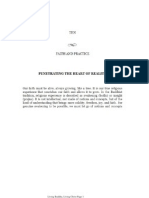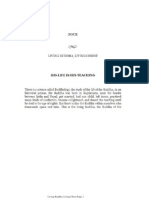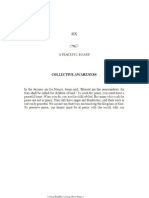Nirvana
| Translations of Nirvana | |
|---|---|
| English | lit. "blown out";[1] extinction of the three fires that cause rebirth[2][3] |
| Sanskrit | निर्वाण (IAST: nirvāṇa) |
| Pali | nibbāna |
| Burmese | နိဗ္ဗာန် (MLCTS: neɪʔbàɰ̃) |
| Chinese | 涅槃 (Pinyin: nièpán) |
| Indonesian | nirwana |
| Japanese | 涅槃 (Rōmaji: nehan) |
| Khmer | និព្វាន (UNGEGN: nĭpvéan) |
| Korean | 열반 (RR: yeolban) |
| Mon | နဳဗာန် ([nìppàn]) |
| Mongolian | Нирваан дүр (nirvaan dür) |
| Shan | ၼိၵ်ႈပၢၼ်ႇ ([nik3paan2]) |
| Sinhala | නිර්වාණ (nivana) |
| Tibetan | མྱ་ངན་ལས་འདས་པ། (mya ngan las 'das pa) |
| Thai | นิพพาน (RTGS: nipphan) |
| Vietnamese | niết bàn |
| Glossary of Buddhism | |
| Translations of Nirvana | |
|---|---|
| English | freedom, liberation |
| Sanskrit | निर्वाण (IAST: nirvāṇa) |
| Bengali | নির্বাণ (nirbanô) |
| Gujarati | નિર્વાણ (nirvāṇa) |
| Hindi | निर्वाण (nirvāṇa) |
| Javanese | ꦤꦶꦂꦮꦤ (nirwana) |
| Kannada | ನಿರ್ವಾಣ (nirvāṇa) |
| Malayalam | നിർവാണം (nirvanam) |
| Nepali | निर्वाण (nirvāṇa) |
| Odia | ନିର୍ବାଣ (nirbaana) |
| Punjabi | ਨਿਰਬਾਣ (nirbāṇa) |
| Tamil | வீடுபேறு (Veeduperu) |
| Telugu | నిర్వాణం (nirvaanam) |
| Glossary of Hinduism terms | |
Nirvāṇa (neer-VAH-nə, /-ˈvænə/ -VAN-ə, /nɜːr-/ nur-;[4] Sanskrit: निर्वाण nirvāṇa [nɪɽʋaːɳɐ]; Pali: nibbāna; Prakrit: ṇivvāṇa; literally, "blown out", as in an oil lamp[1]) is a concept in Indian religions (Buddhism, Hinduism, Jainism, and Sikhism) that represents the ultimate state of soteriological release, the liberation from dukkha and saṃsāra.[3][web 1][5]
In Indian religions, nirvana is synonymous with moksha and mukti.[note 1] All Indian religions assert it to be a state of perfect quietude, freedom, highest happiness as well as the liberation from attachment and worldly suffering and the ending of samsara, the round of existence.[7][8] However, non-Buddhist and Buddhist traditions describe these terms for liberation differently.[9] In Hindu philosophy, it is the union of or the realization of the identity of Atman with Brahman, depending on the Hindu tradition.[10][11][12] In Jainism, nirvana is also the soteriological goal, representing the release of a soul from karmic bondage and samsara.[13] In the Buddhist context, nirvana refers to realization of non-self and emptiness, marking the end of rebirth by stilling the fires that keep the process of rebirth going.[9][14][15] To achieve this status, one has to get rid of three psychological evils – Raga (greed, desire), Dwesha (anger) and Moha (delusion).
Etymology[edit]
The ideas of spiritual liberation, with the concept of soul and Brahman, appears in Vedic texts and Upanishads, such as in verse 4.4.6 of the Brihadaranyaka Upanishad.[16]
The term nirvana in the soteriological sense of "blown out, extinguished" state of liberation does not appear in the Vedas nor in the Upanishads; according to Collins, "the Buddhists seem to have been the first to call it nirvana."[17] This may have been deliberate use of words in early Buddhism, suggests Collins, since Atman and Brahman were described in Vedic texts and Upanishads with the imagery of fire, as something good, desirable and liberating.[18] Collins says the word nirvāṇa is from the verbal root vā "blow" in the form of past participle vāna "blown", prefixed with the preverb nis meaning "out". Hence the original meaning of the word is "blown out, extinguished". (Sandhi changes the sounds: the v of vāna causes nis to become nir, and then the r of nir causes retroflexion of the following n: nis+vāna > nirvāṇa).[19] However the Buddhist meaning of nirvana also has other interpretations.
L. S. Cousins said that in popular usage nirvana was "the goal of Buddhist discipline,... the final removal of the disturbing mental elements which obstruct a peaceful and clear state of mind, together with a state of awakening from the mental sleep which they induce."[20]
Overview[edit]
Nirvāṇa is a term found in the texts of all major Indian religions – Hinduism,[21] Jainism[22] Buddhism,[23] and Sikhism.[24][25] It refers to the profound peace of mind that is acquired with moksha, liberation from samsara, or release from a state of suffering, after respective spiritual practice or sādhanā.[note 2]
The liberation from Saṃsāra developed as an ultimate goal and soteriological value in the Indian culture, and called by different terms such as nirvana, moksha, mukti and kaivalya. This basic scheme underlies Hinduism, Jainism and Buddhism, where "the ultimate aim is the timeless state of moksa, or, as the Buddhists first seem to have called it, nirvana."[29] Although the term occurs in the literatures of a number of ancient Indian traditions, the concept is most commonly associated with Buddhism.[web 1] Some writers believe the concept was adopted by other Indian religions after it became established in Buddhism, but with different meanings and description, for instance the use of (Moksha) in the Hindu text Bhagavad Gita of the Mahabharata.[21]
The idea of moksha is connected to the Vedic culture, where it conveyed a notion of amrtam, "immortality",[30][31] and also a notion of a timeless, "unborn", or "the still point of the turning world of time". It was also its timeless structure, the whole underlying "the spokes of the invariable but incessant wheel of time".[note 3] The hope for life after death started with notions of going to the worlds of the Fathers or Ancestors and/or the world of the Gods or Heaven.[30][note 4]
The earliest Vedic texts incorporate the concept of life, followed by an afterlife in heaven and hell based on cumulative virtues (merit) or vices (demerit).[32] However, the ancient Vedic Rishis challenged this idea of afterlife as simplistic, because people do not live an equally moral or immoral life. Between generally virtuous lives, some are more virtuous; while evil too has degrees, and either permanent heaven or permanent hell is disproportionate. The Vedic thinkers introduced the idea of an afterlife in heaven or hell in proportion to one's merit, and when this runs out, one returns and is reborn.[33][34][35] The idea of rebirth following "running out of merit" appears in Buddhist texts as well.[36] This idea appears in many ancient and medieval texts, as Saṃsāra, or the endless cycle of life, death, rebirth and redeath, such as section 6:31 of the Mahabharata[37] and verse 9.21 of the Bhagavad Gita.[38][39][note 5] The Saṃsara, the life after death, and what impacts rebirth came to be seen as dependent on karma.[42]
Buddhism[edit]
Nirvana (nibbana) literally means "blowing out" or "quenching".[43] It is the most used as well as the earliest term to describe the soteriological goal in Buddhism: release from the cycle of rebirth (saṃsāra).[44] Nirvana is part of the Third Truth on "cessation of dukkha" in the Four Noble Truths doctrine of Buddhism.[44] It is the goal of the Noble Eightfold Path.[45]
The Buddha is believed in the Buddhist scholastic tradition to have realized two types of nirvana, one at enlightenment, and another at his death.[46] The first is called sopadhishesa-nirvana (nirvana with a remainder), the second parinirvana or anupadhishesa-nirvana (nirvana without remainder, or final nirvana).[46]
In the Buddhist tradition, nirvana is described as the extinguishing of the fires that cause rebirths and associated suffering.[47] The Buddhist texts identify these three "three fires"[2] or "three poisons" as raga (greed, sensuality), dvesha (aversion, hate) and avidyā or moha (ignorance, delusion).[48][49]
The state of nirvana is also described in Buddhism as cessation of all afflictions, cessation of all actions, cessation of rebirths and suffering that are a consequence of afflictions and actions.[44] Liberation is described as identical to anatta (anatman, non-self, lack of any self).[50][51] In Buddhism, liberation is achieved when all things and beings are understood to be with no Self.[51][52] Nirvana is also described as identical to achieving sunyata (emptiness), where there is no essence or fundamental nature in anything, and everything is empty.[53][54]
In time, with the development of Buddhist doctrine, other interpretations were given, such as being an unconditioned state,[55] a fire going out for lack of fuel, abandoning weaving (vana) together of life after life,[19] and the elimination of desire.[56] However, Buddhist texts have asserted since ancient times that nirvana is more than "destruction of desire", it is "the object of the knowledge" of the Buddhist path.[57]
Hinduism[edit]
The most ancient texts of Hinduism such as the Vedas and early Upanishads don't mention the soteriological term Nirvana.[21] This term is found in texts such as the Bhagavad Gita[21] and the Nirvana Upanishad, likely composed in the post-Buddha era.[58] The concept of Nirvana is described differently in Buddhist and Hindu literature.[59] Hinduism has the concept of Atman – the soul, self[60][61][62] – asserted to exist in every living being, while Buddhism asserts through its anatman doctrine that there is no Atman in any being.[63][64] Nirvana in Buddhism is "stilling mind, cessation of desires, and action" unto emptiness, states Jeaneane Fowler, while nirvana in post-Buddhist Hindu texts is also "stilling mind but not inaction" and "not emptiness", rather it is the knowledge of true Self (Atman) and the acceptance of its universality and unity with Brahman.[59]
Moksha[edit]
The ancient soteriological concept in Hinduism is moksha, described as the liberation from the cycle of birth and death through self-knowledge and the eternal connection of Atman (soul, self) and metaphysical Brahman. Moksha is derived from the root muc* (Sanskrit: मुच्) which means free, let go, release, liberate; Moksha means "liberation, freedom, emancipation of the soul".[65][66] In the Vedas and early Upanishads, the word mucyate (Sanskrit: मुच्यते)[65] appears, which means to be set free or release - such as of a horse from its harness.
The traditions within Hinduism state that there are multiple paths (Sanskrit: marga) to moksha: jnana-marga, the path of knowledge; bhakti-marga, the path of devotion; and karma-marga, the path of action.[67]
Brahma-nirvana in the Bhagavad Gita[edit]
The term Brahma-nirvana appears in verses 2.72 and 5.24-26 of the Bhagavad Gita.[68] It is the state of release or liberation; the union with the Brahman.[7] According to Easwaran, it is an experience of blissful egolessness.[69]
According to Zaehner, Johnson and other scholars, nirvana in the Gita is a Buddhist term adopted by the Hindus.[21] Zaehner states it was used in Hindu texts for the first time in the Bhagavad Gita, and that the idea therein in verse 2.71-72 to "suppress one's desires and ego" is also Buddhist.[21] According to Johnson the term nirvana is borrowed from the Buddhists to confuse the Buddhists, by linking the Buddhist nirvana state to the pre-Buddhist Vedic tradition of metaphysical absolute called Brahman.[21]
According to Mahatma Gandhi, the Hindu and Buddhist understanding of nirvana are different because the nirvana of the Buddhists is shunyata, emptiness, but the nirvana of the Gita means peace and that is why it is described as brahma-nirvana (oneness with Brahman).[70]However, in 1926, Gandhi delivered a series of discourses on the Gita in the Sabarmati ashram in which he explained that there was no difference between the nias stated bya Buddha and the nirvana of the Gita. They referred to the same state. He related how once the Buddha had fainted while fasting and a woman placed a few drops of milk on his lips... “Did the milk rouse his appetite? No; on the contrary, he realized God soon after.” The Buddha’s nirvana was only “a seeming inertness,” not shunya [nothingness]. It is “perfeinterestednessed s.”16 He had written in a letter earlier that he drew “no distinction between Buddhistic nirvana and the Bnrof ahama Shankara,” as he believed in the complete annihilation of one’s individually as being “an absolute condition of perfect joya and peace.”
Jainism[edit]
The terms moksa and nirvana are often used interchangeably in the Jain texts.[71][72]
Uttaradhyana Sutra provides an account of Sudharman – also called Gautama, and one of the disciples of Mahavira – explaining the meaning of nirvana to Kesi, a disciple of Parshva.[73][note 6]
Sikhism[edit]
The concept of liberation as "extinction of suffering", along with the idea of sansara as the "cycle of rebirth" is also part of Sikhism.[74] Nirvana appears in Sikh texts as the term Nirban.[75][76] However, the more common term is Mukti or Moksh,[77] a salvation concept wherein loving devotion to God is emphasized for liberation from endless cycle of rebirths.[76]
Manichaenism[edit]
The term Nirvana (also mentioned is parinirvana) in the 13th or 14th century Manichaean work "The great song to Mani" and "The story of the Death of Mani", referring to the realm of light.[78]
See also[edit]
Notes[edit]
- ^ Also called vimoksha, vimukti. The Soka Gakkai Dictionary of Buddhism: "Vimoksha [解脱] (Skt; Jpn gedatsu). Emancipation, release, or liberation. The Sanskrit words vimukti, mukti, and moksha also have the same meaning. Vimoksha means release from the bonds of earthly desires, delusion, suffering and transmigration. While Buddhism sets forth various kinds and stages of emancipation, or enlightenment, the supreme emancipation is nirvana,[6][web 2]
- ^ It is sometimes referred to as bhavana, which refers to spiritual "development" or "cultivating" or "producing"[26][27] in the sense of "calling into existence",[28]
- ^ The wheel is a typical Vedic, or Indo-European, symbol, which is manifested in various symbols of the Vedic religion and of Buddhism and Hinduism. See, for examples, Dharmacakra, Chakra, Chakravartin, Kalachakra, Dukkha and Mandala.
- ^ See also Heaven (Christianity) and Walhalla
- ^ Many texts discuss this theory of rebirth with the concepts of Devayana (path of gods) and Pitryana (path of fathers).[40][41]
- ^ The authenticity of this text is in doubt because Parshva, in Jain tradition, lived about 250 years before Mahavira, and his disciple Kesi would have been a few hundred years old when he met the disciple of Mahavira. See Jacobi (1895), footnotes.[73]
References[edit]
- ^ a b Richard Gombrich, Theravada Buddhism: A Social History from Ancient Benāres to Modern Colombo. Routledge
- ^ a b Gombrich 2006, p. 65.
- ^ a b Chad Meister (2009). Introducing Philosophy of Religion. Routledge. p. 25. ISBN 978-1-134-14179-1.
Buddhism: the soteriological goal is nirvana, liberation from the wheel of samsara and extinction of all desires, cravings and suffering.
- ^ "nirvana". Random House Webster's Unabridged Dictionary.
- ^ Kristin Johnston Largen. What Christians Can Learn from Buddhism: Rethinking Salvation. Fortress Press. pp. 107–108. ISBN 978-1-4514-1267-3.
One important caveat must be noted: for many lay Buddhists all over the world, rebirth in a higher realm – rather than realizing nirvana – has been the primary religious goal. [...] while many Buddhists strongly emphasize the soteriological value of the Buddha's teaching on nirvana [escape from samsara], many other Buddhists focus their practice on more tangible goals, in particular on the propitious rebirth in one's next life.
- ^ "IN THE PRESENCE OF NIBBANA:Developing Faith in the Buddhist Path to Enlightenment". What-Buddha-Taught.net. Retrieved 22 October 2014.
- ^ a b Gavin Flood, Nirvana. In: John Bowker (ed.), Oxford Dictionary of World Religions
- ^ Anindita N. Balslev (2014). On World Religions: Diversity, Not Dissension. SAGE Publications. pp. 28–29. ISBN 978-93-5150-405-4.
- ^ a b Loy, David (1982). "Enlightenment in Buddhism and Advaita Vedanta". International Philosophical Quarterly. Philosophy Documentation Center. 22 (1): 65–74. doi:10.5840/ipq19822217.
What most distinguishes Indian from Western philosophy is that all the important Indian systems point to the same phenomenon: Enlightenment or Liberation. Enlightenment has different names in the various systems – kaivalya, nirvana, moksha, etc. – and is described in different ways...
- ^ Brian Morris (2006). Religion and Anthropology: A Critical Introduction. Cambridge University Press. p. 51. ISBN 978-0-521-85241-8.
There has been some dispute as to the exact meaning of nirvana, but clearly the Buddhist theory of no soul seems to imply quite a different perspective from that of Vedantist philosophy, in which the individual soul or self [atman] is seen as identical with the world soul or Brahman [god] (on the doctrine of anatta [no soul] ...
- ^ Gwinyai H. Muzorewa (2000). The Great Being. Wipf. pp. 52–54. ISBN 978-1-57910-453-5.
Even the Atman depends on the Brahman. In fact, the two are essentially the same. [...] Hindu theology believes that the Atman ultimately becomes one with the Brahman. One's true identity lies in realizing that the Atman in me and the Brahman - the ground of all existence - are similar. [...] The closest kin of Atman is the Atman of all living things, which is grounded in the Brahman. When the Atman strives to be like Brahman it is only because it realizes that that is its origin - God. [...] Separation between the Atman and the Brahman is proved to be impermanent. What is ultimately permanent is the union between the Atman and the Brahman. [...] Thus, life's struggle is for the Atman to be released from the body, which is impermanent, to unite with Brahman, which is permanent - this doctrine is known as Moksha.
- ^ Fowler 2012, p. 46: "Shankara interpreted the whole of the Gita as extolling the path of knowledge as the best means to moksha, and a total identity of the atman with Brahman...,
- ^ John E. Cort (1990), MODELS OF AND FOR THE STUDY OF THE JAINS, Method & Theory in the Study of Religion, Vol. 2, No. 1, Brill Academic, pages 42-71
- ^ Collins 1990, pp. 81–84.
- ^ Peter Harvey (2001). Buddhism. Bloomsbury Academic. pp. 98–99. ISBN 978-1-4411-4726-4.
[Nirvana is] beyond the processes involved in dying and reborn. [...] Nirvana is emptiness in being void of any grounds for the delusion of a permanent, substantial Self, and because it cannot be conceptualized in any view which links it to 'I' or 'mine' or 'Self'. It is known in this respect by one with deep insight into everything as not-Self (anatta), empty of Self.
- ^ Max Müller (2011). Theosophy Or Psychological Religion. Cambridge University Press. pp. 307–310. ISBN 978-1-108-07326-4.
- ^ Collins 1998, pp. 137–138.
- ^ Collins 1998, p. 216–217.
- ^ a b Collins 2010, pp. 63–64.
- ^ The Concise Routledge Encyclopedia of Philosophy. 2000. p. 632.
- ^ a b c d e f g Fowler 2012, p. 48.
- ^ Helmuth von Glasenapp (1999). Jainism: An Indian Religion of Salvation. Motilal Banarsidass. pp. 234, 492. ISBN 978-81-208-1376-2.
- ^ Trainor 2004, p. 68.
- ^ Pruthi 2004, p. 200.
- ^ Duiker & Spielvogel 2008, pp. 52–53.
- ^ Pali Text Society (1921–1925). "Bhāvanā". The Pali Text Society's Pali-English dictionary. London: Chipstead. p. 503. Retrieved 27 January 2022 – via Digital Dictionaries of South Asia.
- ^ Monier-Williams (1899). "Bhāvana" and "Bhāvanā" (PDF). p. 755. Retrieved 9 December 2008 – via U. Cologne.
- ^ Nyanatiloka 1980, p. 67.
- ^ Collins 2010, p. 31.
- ^ a b Collins 2010, p. 29.
- ^ Collins 1998, p. 136.
- ^ James Hastings; John Alexander Selbie; Louis Herbert Gray (1922). Encyclopædia of Religion and Ethics. T. & T. Clark. pp. 616–618. ISBN 9780567065124.
- ^ Frazier 2011, pp. 84–86.
- ^ Atsushi Hayakawa (2014). Circulation of Fire in the Veda. LIT Verlag Münster. pp. 101–103 with footnote 262. ISBN 978-3-643-90472-0.
The concept of punarmrtyu appeared, which conveys that even those who participated in rituals die again in the life after death when the merit of the ritual runs out.
- ^ Krishan, Yuvraj (1997). The Doctrine of Karma: Its Origin and Development in Brāhmaṇical, Buddhist, and Jaina Traditions. Bharatiya Vidya Bhavan. pp. 17–27. ISBN 9788120812338.;
The New Encyclopædia Britannica. Vol. 8. Encyclopædia Britannica. 1998. p. 533. ISBN 978-0-85229-633-2.[These Upanishadic texts] record the traditions of sages (Rishis) of the period, notably Yajnavalkya, who was a pioneer of new religious ideas. [...] Throughout the Vedic period, the idea that the world of heaven was not the end – and that even in heaven death was inevitable – had been growing. [...] This doctrine of samsara (reincarnation) is attributed to sage Uddalaka Aruni, [...] In the same text, the doctrine of karma (actions) is attributed to Yajnavalkya...
- ^ Patrul Rinpoche (1998). The Words of My Perfect Teacher. Boston: Shambhala. pp. 95–96. ISBN 978-0-7619-9027-7.
After enjoying the happiness of a celestial realm, when his merit runs out he will be reborn here.
Patrul Rinpoche (1998). "The Words of My Perfect Teacher" (PDF). Archived from the original (PDF) on 10 May 2017. - ^ Frazier 2011, pp. 84–86, Quote: "They reach the holy world of Indra and enjoy the celestial pleasures of the gods in heaven, but having enjoyed the vast world of heaven, they come back to the world of mortals when their merit runs out. So, by following the injunctions of the three Vedas with a desire for pleasures, they get to travel to and fro. (Mahābhārata 6.31:20–1)".
- ^ Christopher Key Chapple, ed. (2010). The Bhagavad Gita: Twenty-fifth–Anniversary Edition. Translated by Winthrop Sargeant. State University of New York Press. p. 397. ISBN 978-1-4384-2840-6.
Having enjoyed the vast world of heaven, they enter the world of mortals when their merit is exhausted. Thus conforming to the law of the three Vedas, Desiring enjoyments, they obtain the state of going and returning.
- ^ Yuvraj Krishan (1988), Is Karma Evolutionary?, Journal of Indian Council of Philosophical Research, Volume 6, pages 24-26
- ^ Surendranath Dasgupta (1956). A History of Indian Philosophy. Cambridge University Press. pp. 520–522.
- ^ Paul Deussen (2015). The System of the Vedanta: According to Badarayana's Brahma-Sutras and Shankara's Commentary thereon. KB Classics. pp. 357–359. ISBN 978-1-5191-1778-6.
- ^ Collins 2010, p. 30.
- ^ Collins 1998, p. 191.
- ^ a b c Buswell & Lopez 2014, pp. 589–590.
- ^ Keown 2004, pp. 194–195.
- ^ a b Buswell & Lopez 2014, p. 590.
- ^ "nirvana". Encyclopædia Britannica. Retrieved 22 October 2014.
- ^ Gombrich 2006, p. 66.
- ^ Buswell & Lopez 2014, p. 589.
- ^ Collins 1990, pp. 82, 84: "Like all other things or concepts (dhammā) it is anattā, 'not-self. Whereas all 'conditioned things' (samkhāra - that is, all things produced by karma) are 'unsatisfactory and impermanent' (sabbe samkhāra dukkhā . . . aniccā) all dhammā whatsoever, whether conditioned things or the unconditioned nibbāna, are 'not-self (sabbe dhammā anattā). [...] The absolute indescribability of nirvana, along with its classification as anattā, 'not-self, has helped to keep the separation intact, precisely because of the impossibility of mutual discourse."
- ^ a b Sue Hamilton (2000). Early Buddhism: A New Approach : the I of the Beholder. Routledge. pp. 18–21. ISBN 978-0-7007-1280-9. Quote: "The corrected interpretation they offered, widely accepted to his day, still associated anatta with nirvana. What it means, it was now states, is that in order to achieve liberation you need to understand that you are not, and nor do you have, and nor have you ever been or had, an abiding self."
- ^ Paul Williams; Anthony Tribe (2000). Buddhist Thought. Routledge. p. 61. ISBN 978-0-415-20701-0.
He makes no mention of discovering the True Self in the Anattalakkhana Sutta. As we have seen, the Buddha explains how liberation comes from letting-go of all craving and attachment simply through seeing that things are not Self anatta. That is all there is to it. One cuts the force that leads to rebirth and suffering. There is no need to postulate a Self beyond all this. Indeed any postulated Self would lead to attachment, for it seems that for the Buddha a Self fitting the description could legitimately be a suitable subject of attachment. There is absolutely no suggestion that the Buddha thought there is some additional factor called the Self (or with any other name, but fitting the Self-description) beyond the five aggregates.
- ^ Mun-Keat Choong (1999). The Notion of Emptiness in Early Buddhism. Motilal Banarsidass. pp. 1–4, 85–88. ISBN 978-81-208-1649-7.
Emptiness is a characteristically Buddhist teaching. The present study is concerned with this teaching of emptiness (P. sunnata, Skt. sunyata) as presented in the texts of early Buddhism. [...] The teaching of emptiness is recognized as the central philosophy of early Mahayana. However, this teaching exists in both early Buddhism and early Mahayana Buddhism, where it is connected with the meaning of conditioned genesis, the middle way, nirvana and not-self (P. anatta, Skt. anatman).
, - ^ Ray Billington (2002). Understanding Eastern Philosophy. Routledge. pp. 58–60, 136. ISBN 978-1-134-79348-8., Quote (p 59-60): "We may better understand what anatman implies if we examine Nagarjuna's concept of the void: shunyata or emptiness. Nagarjuna argued that there is no such thing as the fundamental nature, or essence, of anything. (...) In a word, all is emptiness, shunyata; instead of essence, there is a void. (...) everything is empty."; Quote (p 136): "What we can say, whichever branch of Buddhism we may have in mind, is that the state of nirvana, to which all Buddhists aspire, is like samadhi, a non-dual state. (...) the Buddhist concept of enlightened mind - bodhichitta - refers to a state beyond desire (dukkha) whereby the one who seeks nirvana has achieved shunyata, the emptiness or void described on pages 58-9."
- ^ John J. Makransky (1997). Buddhahood Embodied: Sources of Controversy in India and Tibet. State University of New York Press. p. 85. ISBN 978-0-7914-3431-4.
- ^ Charles S. Prebish (2010). Buddhism: A Modern Perspective. Penn State Press. pp. 134–135. ISBN 978-0-271-03803-2.
- ^ Collins 2010, p. 54.
- ^ Olivelle 1992, pp. 5–9, 227–235, Quote: "Nirvana Upanishad...".
- ^ a b Fowler 2012, pp. 48–49.
- ^ "Atman (in Oxford Dictionaries)". Oxford University Press. 2012.
Quote: 1. real self of the individual; 2. a person's soul
- ^ Constance Jones; James D. Ryan (2006). Encyclopedia of Hinduism. Infobase. p. 51. ISBN 978-0-8160-7564-5.; Quote: The atman is the self or soul.
- ^ David Lorenzen (2004). Mittal, Sushil; Thursby, Gene (eds.). The Hindu World. Routledge. pp. 208–209. ISBN 9781134608751.
Advaita and nirguni movements, on the other hand, stress an interior mysticism in which the devotee seeks to discover the identity of individual soul (atman) with the universal ground of being (brahman) or to find god within himself.
- ^ [a] Anatta, Encyclopædia Britannica (2013), Quote: "Anatta in Buddhism, the doctrine that there is in humans no permanent, underlying soul. The concept of anatta, or anatman, is a departure from the Hindu belief in atman ("the self").";
[b] Steven Collins (1994), Religion and Practical Reason (Editors: Frank Reynolds, David Tracy), State Univ of New York Press, ISBN 978-0791422175, page 64; "Central to Buddhist soteriology is the doctrine of not-self (Pali: anattā, Sanskrit: anātman, the opposed doctrine of ātman is central to Brahmanical thought). Put very briefly, this is the [Buddhist] doctrine that human beings have no soul, no self, no unchanging essence.";
[c] John C. Plott et al (2000), Global History of Philosophy: The Axial Age, Volume 1, Motilal Banarsidass, ISBN 978-8120801585, page 63, Quote: "The Buddhist schools reject any Ātman concept. As we have already observed, this is the basic and ineradicable distinction between Hinduism and Buddhism";
[d] Katie Javanaud (2013), Is The Buddhist 'No-Self' Doctrine Compatible With Pursuing Nirvana?, Philosophy Now;
[e] David Loy (1982), Enlightenment in Buddhism and Advaita Vedanta: Are Nirvana and Moksha the Same?, International Philosophical Quarterly, Volume 23, Issue 1, pages 65-74 - ^ [a] Christmas Humphreys (2012). Exploring Buddhism. Routledge. pp. 42–43. ISBN 978-1-136-22877-3.
[b] Richard Gombrich (2006). Theravada Buddhism. Routledge. p. 47. ISBN 978-1-134-90352-8.Buddha's teaching that beings have no soul, no abiding essence. This 'no-soul doctrine' (anatta-vada) he expounded in his second sermon.
, - ^ a b मुच Monier-Williams Sanskrit English Dictionary, Germany (2008)
- ^ Heinrich Robert Zimmer (1951). Philosophies of India. Princeton University Press. p. 41. ISBN 0-691-01758-1.
Moksa, from the root muc, "to loose, set free, let go, release, liberate, deliver" [...] means "liberation, escape, freedom, release, rescue, deliverance, final emancipation of the soul.
- ^ Chad Meister (2009). Introducing Philosophy of Religion. Routledge. p. 25. ISBN 978-1-134-14179-1.
- ^ Christopher Key Chapple, ed. (2010). The Bhagavad Gita: Twenty-fifth–Anniversary Edition. Translated by Winthrop Sargeant. State University of New York Press. pp. 157, 266–268. ISBN 978-1-4384-2840-6.
- ^ Easwaran 2007, p. 268.
- ^ Mahatma Gandhi (2009), John Strohmeier (ed.), The Bhagavad Gita – According to Gandhi, North Atlantic Books, p. 34,
The nirvana of the Buddhists is shunyata, emptiness, but the nirvana of the Gita means peace and that is why it is described as brahma-nirvana [oneness with Brahman]
- ^ Jaini, Padmanabh (2000). Collected Papers on Jaina Studies. Delhi: Motilal Banarsidass Publ. ISBN 81-208-1691-9.: "Moksa and Nirvana are synonymous in Jainism". p. 168
- ^ Michael Carrithers, Caroline Humphrey (1991) The Assembly of listeners: Jains in society Cambridge University Press. ISBN 0521365058: "Nirvana: A synonym for liberation, release, moksa." p. 297
- ^ a b Jacobi, Hermann; Ed. F. Max Müller (1895). Uttaradhyayana Sutra, Jain Sutras Part II, Sacred Books of the East, Vol. 45. Oxford: The Clarendon Press.
- ^ William Owen Cole; Piara Singh Sambhi (1995). The Sikhs: Their Religious Beliefs and Practices. Sussex Academic Press. p. 68. ISBN 978-1-898723-13-4.
- ^ Arvind-Pal Singh Mandair (2013). Sikhism: A Guide for the Perplexed. Bloomsbury Academic. pp. 219–220. ISBN 978-1-4411-5366-1.
- ^ a b H. S. Singha (2000). The Encyclopedia of Sikhism. Hemkunt Press. p. 148. ISBN 978-81-7010-301-1.
- ^ W. H. McLeod (2009). The A to Z of Sikhism. Scarecrow. pp. 134–. ISBN 978-0-8108-6344-6.
- ^ Willis Barnstone, Marvin Meyer The Gnostic Bible: Revised and Expanded Edition Shambhala Publications 2009 ISBN 978-0-834-82414-0 page 669
Online references[edit]
- ^ a b "Donald S. lopez Jr., Nirvana, Encyclopædia Britannica".
- ^ "The Soka Gakkai Dictionary of Buddhism, vimoksha". Archived from the original on 22 February 2014. Retrieved 17 February 2014.
Sources[edit]
- Buswell, Robert E.; Lopez, Donald S. (2014). The Princeton Dictionary of Buddhism. Princeton University Press. ISBN 978-1-4008-4805-8.
- Collins, Steven (1990). Selfless Persons: Imagery and Thought in Theravada Buddhism. Cambridge University Press. ISBN 978-0-521-39726-1.
- Collins, Steven (1998), Nirvana and Other Buddhist Felicities, Cambridge University Press, ISBN 978-0-521-57054-1
- Collins, Steven (2010), Nirvana: Concept, Imagery, Narrative, Cambridge University Press, ISBN 978-0-521-88198-2
- Duiker, William J.; Spielvogel, Jackson J. (2008). World History: To 1800. ISBN 9780495050537.
- Easwaran, Eknath (2007), The Bhagavad Gita:(Classics of Indian Spirituality), Nilgiri Press, ISBN 9781586380199
- Frazier, Jessica (2011), The Continuum Companion to Hindu Studies, Continuum International Publishing Group, ISBN 978-0-8264-9966-0
- Fowler, Jeaneane D. (2012), The Bhagavad Gita: A Text and Commentary for Students, Sussex Academic Press, ISBN 9781845193461
- Gombrich, Richard F. (2006). How Buddhism Began: The Conditioned Genesis of the Early Teachings. Routledge. ISBN 978-1-134-19639-5.
- Keown, Damien (2004). A Dictionary of Buddhism. Oxford University Press. ISBN 978-0-19-157917-2.
- Nyanatiloka, Mahathera (1980), Buddhist Dictionary: Manual of Terms And Doctrines (4th ed.), Kandy, Sri Lanka: Buddhist Publication Society
- Olivelle, Patrick (1992). The Samnyasa Upanisads: Hindu Scriptures on Asceticism and Renunciation. Oxford University Press. ISBN 9780195361377.
- Pruthi, R.K. (2004). Sikhism And Indian Civilization. ISBN 9788171418794.
- Trainor, Kevin (2004), Buddhism: The Illustrated Guide, Oxford University Press, ISBN 978-0-19-517398-7
Further reading[edit]
- Brahm, Ajahn (2006). Mindfulness, Bliss, and Beyond: A Meditator's Handbook (PDF). Wisdom Publications. ISBN 9780861712755. Archived from the original (PDF) on 5 March 2016. Retrieved 13 June 2016.
- Kawamura (1981). Bodhisattva Doctrine in Buddhism. Wilfrid Laurier University Press.
- Lindtner, Christian (1997). "Problems of Pre-Canonical Buddhism". Buddhist Studies Review. 14 (2).
- Nananaranda, Katukurunde (2012). Nibbana - The Mind Stilled (Vol. I-VII). Dharma Grantha Mudrana Bharaya.
- Williams, Paul; Tribe, Anthony (2000). Buddhist Thought. Routledge. ISBN 978-0-415-20701-0.
- Yogi Kanna (2011). Nirvana: Absolute Freedom. Kamath Publishings.
External links[edit]
| Wikiquote has quotations related to: Nirvana |
| Look up nirvana in Wiktionary, the free dictionary. |




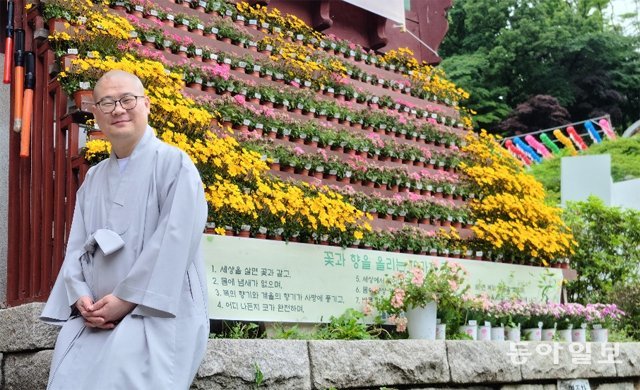 21일 꽃단장한 화계사에서 웃음꽃을 피운 광우 스님은 ‘미소 명상법’을 권했다. 미소를 지으면서 속으로 ‘아, 좋다’ ‘편안합니다’ ‘감사합니다’ ‘행복합니다’라는 희망의 단어들을 떠올리는 것이다. 김갑식 문화전문기자 dunanworld@donga.com
21일 꽃단장한 화계사에서 웃음꽃을 피운 광우 스님은 ‘미소 명상법’을 권했다. 미소를 지으면서 속으로 ‘아, 좋다’ ‘편안합니다’ ‘감사합니다’ ‘행복합니다’라는 희망의 단어들을 떠올리는 것이다. 김갑식 문화전문기자 dunanworld@donga.com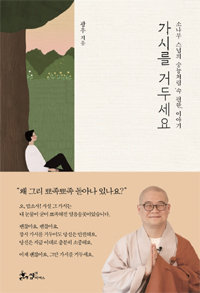 《21일 서울 강북구 화계사에서 만난 광우 스님(41)은 동안(童顔)이었다. 주변의 소담스러운 꽃들과 그의 웃음꽃이 잘 어우러졌다.
《21일 서울 강북구 화계사에서 만난 광우 스님(41)은 동안(童顔)이었다. 주변의 소담스러운 꽃들과 그의 웃음꽃이 잘 어우러졌다. 

